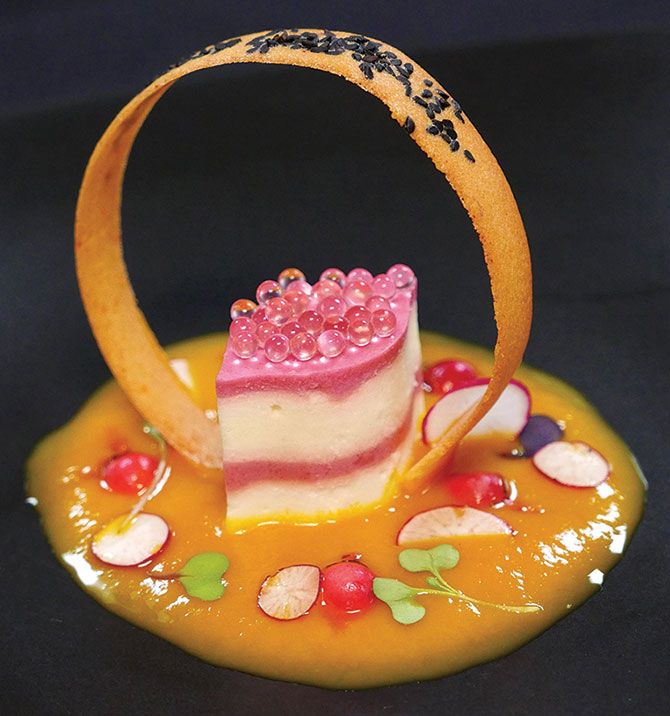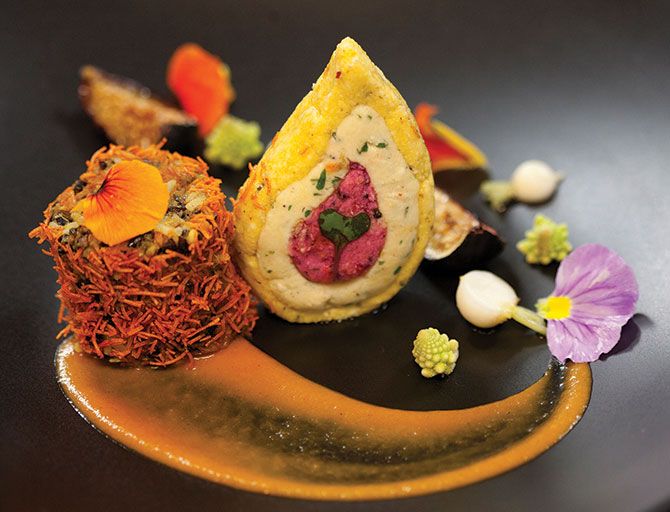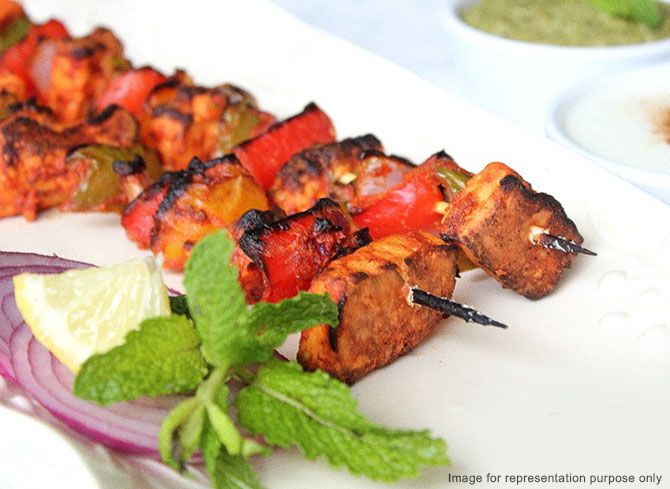Master Chef Vikas Khanna served a seven-course, 26 dish, meal for Prime Minister Narendra Modi's dinner for Fortune 500 CEOs in New York.
His recipes, exclusively on Rediff.com
At the Fortune 500 dinner hosted in Prime Minister Narendra Modi's honour at the Waldorf Astoria hostel, Master Chef Vikas Khanna -- who has won a Michelin Star five times, the latest on September 30 -- conceived a delicious seven-course meal.
There were 26 dishes on the menu, each representing a festival in India, presented in a way that delighted both Modi and his guests.
Presenting the top recipes from Vikas Khanna's kitchen:
Shigmoutsav Sol Kadi and Pongal Coconut Chutney Mousse

Photograph: Courtesy Chef Vikas Khanna
All along the Konkan coast you will encounter some form of Sol Kadi -- a smooth pinkish-mauve liquid with a complexity of flavours that dance on the tongue: The sourness of kokum, the silky sweetness of the coconut milk and then a burst of spice that surprises and delights all at once.
Served in a glass or in a small bowl with your meal it is both aperitif and curry, depending on whether you want to whet your appetite with its cool tang or pour it over steamed rice.
Kokum is the dried rind or peel of a purplish red fruit (Garcinia Indica) in the mangosteen family.
The sour pulp of the fruit is eaten with salt, but it is prized for its rind, which is dried in small petal shapes to add as a souring agent in curries and vegetables dishes.
Kadi, or Sol Kadi, as it is known outside Goa, has many regional variants: Green chillies, fresh coriander and garlic may be added, or it may be seasoned with fried mustard or cumin seeds; it may also be served chilled, warm or at room temperature.
The coconut chutney here is the basic recipe, which can accompany any South Indian snack.
It contains no peanuts, just grated coconut and spices.
Coconut Chutneys can be as dry and firm or as runny as you like.
Most Indian homes have a special coconut grater that extracts the coconut flesh from a coconut half in neat curls.
Table-top graters have replaced the traditional metal ones fitted into wooden planks or benches, with the grater at the end of a long curved arm that also doubles up as a sharp knife for cutting vegetables and fish!
South Indian chutneys usually call for a final burst of flavour and texture that is provided by spices tempered in oil, as does this one. You can also add a few split black lentils or split chickpeas to the seasoning for added crunch.
Ingredients
For Sol Kadi
- 12 pieces of kokum rind
- 2 cups fresh coconut, grated
- 6 cloves garlic
- 1-inch fresh ginger
- 1/2 tsp chili powder
- 6 black peppercorns
- 1/2 tsp oil
- 1/4 tsp black mustard seeds
- Salt
- 16 gm Agar Agar, divided
- 0.5 gm soy lecithin, divided
For Coconut Chutney
- 1 cup fresh coconut, grated
- 2 tsp split black chickpeas, roasted
- 2-3 green chillies, chopped
- 12 mm (1/2-inch) piece fresh ginger, chopped
- 1 tsp tamarind paste
- 2 tsp vegetable oil
- 1/2 tsp black mustard seeds
- 1 dried red chilli, torn in half
- 8 fresh curry leaves
Method
For Sol Kadi
- In a bowl, soak the kokum in 2 cups of water for at least 1 hour.
- Strain, pressing the rinds down with a spoon to extract as much pulp as possible. Discard the solids.
- Grind the coconut, garlic, ginger, chilli powder and peppercorns to a fine paste.
- Add 1 and 1/2 cups water and strain, pressing the solids to extract the coconut milk.
- Transfer the liquid to a bowl and stir in the kokum extract and salt to taste.
- In a small pan over medium heat, transfer 250 gm of Sol Kadi and 8 gm of Agar Agar and pinch of soy lecithin.
- Very gently, bring it to a boil, whisking occasionally until well combined. Pour the liquid into a container and keep warm.
For coconut chutney
- Grind the coconut, split chickpeas, green chillies, ginger, tamarind, salt to taste and a little water in a processor or grinder to a smooth paste. Transfer to a bowl.
- Heat the oil in a small pan. Add the mustard seeds and when they begin to splutter, add the red chilli and curry leaves and sauté for a few seconds. Pour over the chutney.
- Using a triple layered cheesecloth, strain the coconut chutney.
- In a small pan over medium heat, transfer 250 gm of coconut chutney, 8 gm of Agar Agar and pinch of soy lecithin.
- Very gently, bring it to a boil, whisking occasionally until well combined.
- Pour the liquid into a container and keep warm.
To assemble
- On a baking sheet, place a 1/4-inch layer of sol kadi mixture; let is set for a minute.
- Very gently add a 1/4-inch layer of coconut chutney; let it set for a minute.
- Top with another 1/4 -inch layer of sol kadi and let it set. Cut in desired shape.
Cheti Chand Papad Subzi Crisp
Papads or poppadoms are an integral part of Sindhi cuisine.
A meal without the lentil crisp would be inconceivable in a Sindhi household.
Papads are made in a range of sizes from small cocktail bites to large crisp platters, and flavours from garlic to pepper and mixed spices.
While most papads are made of a single lentil or a combination of lentils, a variety of rice papad called Kheecha is a particular Sindhi favourite.
Papads are eaten with breakfast lunch and dinner and for many Sindhis a meal begins and ends with papad.
Not only are they eaten on their own or as a snack, papads are also crushed into salads, and soaked in curries adding their flavour and texture to the dish.
So central are papads to a Sindhi way of life that guests are welcomed into a Sindhi home with a glass of water and a crisp roasted papad.
Ingredients
- 4 x 15-cm (6-inch) papads of any flavour
- 1 tbsp vegetable oil
- 1/2 tsp cumin seeds
- 6 fresh curry leaves
- 1 tsp coriander, ground
- 1/2 tsp garam masala
- 1/4 tsp sugar
- Salt
- 1 tbsp nigella seeds
Method
- Dry roast the papads over medium heat until crisp; break them into medium-sized pieces.
- Heat oil in a pan over medium heat; add the cumin seeds and curry leaves and when they start to sizzle, sauté on low heat for 1 or 2 minutes.
- Add the coriander, garam masala, sugar and salt to taste.
- Saute for 2 or 3 minutes until the oil starts separating from the mixture.
- Add a little water and bring the mixture to a boil.
- Add papad, stir to mix and take the pan off the heat.
- Using a high-quality magnetic blender, puree all the ingredients to a fine mixture on high speed.
- Thinly spread on a fruit roll sheet and place it in a dehydrator, sprinkle with nigella seeds and dry for 2 hours at 145°F.
- Remove the tray and cut them into thin strips, long enough to be rolled around a 4-inch cookie cutter.
- Once it takes a round shape, place it back onto the fruit roll sheet and place it back in the dehydrator, and dry until crispy like a papad. Use it as a garnish as required.
Kolhapur Smoked Chilli Pearls
Ingredients
Dry elements
- 10-12 bedgi chilies, de-seeded
- 2 tbsp split chickpeas (chana dal)
- 1 gm stone flower
- 1 tbsp cumin seeds
- 1 tbsp coriander seeds
- Pinch of fenugreek seeds
- 1 tsp poppy seeds
- 1 tsp peppercorns
- 3-4 green cardamom
- 1 bay leaf
- 1 tsp triphal or sichuan pepper
- 3 cloves
- 1 whole star anise
- 1-inch cinnamon
- 1 tsp fennel seeds
- Pinch of saffron
- 1 black cardamom
- 1 tbsp sesame seeds
Powders
- 1 tsp turmeric powder
- 1 tbsp smoked paprika
- 1 tsp whole wheat flour
- Pinch of asafetida
- Pinch of nutmeg
- Salt
- 1.5 gm Agar Agar
Oil Bath
1 cup of oil
Method
- Dry roast all spices except powders in a heavy bottom skillet on very low heat, stirring continuously, until very fragrant and darker in colour.
- Using a high-quality spice grinder, grind the whole spices along with the powders and salt, until very fine.
- Combine 25 gm of the masala and 75 gm of distilled water in a magnetic blender and blend until smooth, adjust salt if required.
- Using electric blender helps to avoid formation of bubbles. Strain using a double layered muslin cloth. Make sure liquid weighs exactly 100 gm.
- Pour oil in a tall glass and place in the freezer for an hour.
- Combine chilli mixture with agar agar and bring it to boil over high heat, stirring continuously with an immersion blender.
- Remove from heat and skim off the froth. Let it cool till temperature reaches 120 degree F.
- Fill a syringe with the chilli-agar mixture and dispense it in drops into the cold oil, making sure that the drops fall separate from each other.
- Leave them in the cold for a few minutes and remove with a slotted spoon; rinse them in water and store in a closed container in the refrigerator. Use for garnish as needed.
Onam Beetroot Poriyal

Photograph: Courtesy Chef Vikas Khanna
The parade of spiced vegetables during a sadhya continues with one delectable dish following the other. One of the courses is Thoran.
Thorans or Upperis are vegetables that are stir-fried or steamed with spices and coconut and belong to the same family of dishes as the Poriyals of Tamil Nadu and Foogaths of Goa.
The traditional method of softening the vegetables is to cook them in their own steam without water, by covering the pan with a deep lid with some water in it.
The steam generated by cooking condenses when it hits the lid and falls right back in allowing the vegetable to cook without any additional water.
The vegetables are then stir-fried with coconut until all the water has evaporated.
The idea is to keep the vegetables as crunchy and fresh as possible. Any vegetable can be cooked as a Thoran, including leafy greens.
Ingredients
- 1 tbsp coconut oil
- 1/4 tsp mustard seeds
- 2 dried red chillies, torn into pieces
- 10 fresh curry leaves
- 3 green chillies, slit lengthwise
- 1/4 tsp turmeric
- 225 grams (8 ounces) beetroot, finely grated
- Salt
- 1/2 cup fresh coconut, grated
- 1/2 cup coconut milk, freshly extracted if possible
- 6.5 gram iota carrageenan
Method
- Heat the oil in a pan over medium heat; add the mustard seeds and when they begin to splutter add the red chillies, curry leaves and green chillies and saute for a few seconds.
- Add turmeric and mix well.
- Add the beetroot and salt to taste; stir well and cook, covered, for 5 minutes until the beetroot is just tender. Add the coconut and cook until flavours merge.
- Remove from heat and add coconut milk and iota carrageenan and blend using an immersion blender.
- Heat mixture until temperature reaches 176 degree F, whisking occasionally, until combined well.
- Pour into moulds of desired shape and set.
Baisakhi Paneer Tikka

Photograph: s4's world/Creative Commons
Tandoors do more than grill chicken and bake bread.
A host of other foods are grilled to smoky perfection in the cavernous clay ovens.
Tikkas are cubes of meat, seafood or vegetable that are marinated in spices and fried or grilled.
Usually served as an appetizer or snack, these small bites are popular in Punjab.
The marinade for these Cottage Cheese Tikkas is similar to that used for Tandoori Chicken, which is why Paneer Tikka is considered to be a vegetarian Chicken Tikka.
Baisakhi is the perfect occasion to serve these Tikkas, as Sikhs and Punjabis maintain a strictly vegetarian diet for the major part of the day.
Ingredients
- 1 and 1/2 cups plain yogurt, whisked
- 3 tbsp mustard oil
- 1 tbsp fresh lime juice
- 1 tbsp ginger paste
- 1 tbsp garlic paste
- 1 tsp garam masala powder
- Salt
- Black pepper, freshly ground
- 500 grams (about 1 pound) paneer, cut into 5-cm (2-inch) cubes
- 4 Freshly ground vegetable oil
- 125 gm of fresh goat milk
- 6.5 gram iota carrageenan
Method
- In a mixing bowl, combine the yogurt with all the ingredients except the paneer and vegetable oil, and whisk well.
- Cover and let stand for 20 minutes to allow the flavours to blend.
- Add the paneer and toss gently with the yogurt marinade. Cover and marinate for two hours.
- Thread the marinated paneer onto skewers and barbecue over hot coals, basting with the vegetable oil, until cooked.
- In a saucepan, combine 175 gm of crumbled paneer, with 125 gm of fresh goat milk and bring the mixture to a boil. Remove from heat, cover and allow flavours to merge.
- Add iota careegan and blend using an immersion blender.
- Heat mixture until temperature reaches 176 degree F, whisking occasionally, until combined well.
- Pour into moulds of desired shape and set.
Rosh Hashanah Ginger infused Pumpkin Mousse
Ingredients
- 1 cup heavy cream
- 8 gm ginger powder
- 1 tbsp fennel seeds, finely ground
- 250 gm pumpkin puree
Method
- In a non-reactive mixing bowl, combine all ingredients until well mixed.
- Strain and pour into ISI whip and chill for at least two hours.
- To serve: Charge ISI Whip with one ISI cream charger and shake vigorously and serve immediately.



